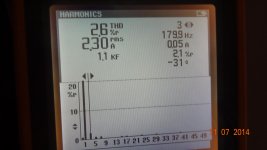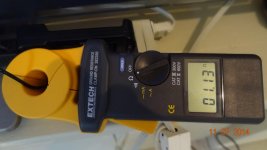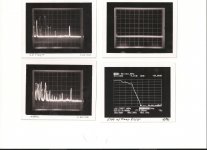The subjective aspect of switching power supplies has to be addressed.
It has been usually shown that for both power amps and preamps, switching supplies are inferior to linear supplies. Even with the best audio equipment.
You will find that the cheapest mid fi uses switching supplies, and the noise gets 'everywhere'. Linear is so much 'cleaner'.
It has been usually shown that for both power amps and preamps, switching supplies are inferior to linear supplies. Even with the best audio equipment.
You will find that the cheapest mid fi uses switching supplies, and the noise gets 'everywhere'. Linear is so much 'cleaner'.
meaningful technical discussion
George
For everyone else, don't "believe". Be scientific: Try to make your own opinion. (If possible)Go for it, Gpapag. If ONLY everyone was as sophisticated in circuit design as you are, then I would not have to post a warning.
For everyone else, stick with linear supplies, if possible.
Try means: Measure, compare, listen, try to find the causes of what you listened.
As i believed "usually shown" best results of linear PSUs, i was very surprised, some years ago, to see one of my amp incredibly better when i changed the PSU for an SMPS...
Recently, Andrej (Lazy Cat) tried the same (on my insistence ?) with his VSSA that he designed with big linears.. And found SMPS from Hypex as a definitive winner.
He organized a blind test with several participants between Linear, and 3 different SMPS (Hypex, Connexelectronics, PA) and the same amp (First One modules). The non regulated SMPS from Hypex was the clear and unanimous winner.
This correlate my own conclusions.
if i was a "believer", John, who do you think i could believe more ? The one who stands on his old 'opinions', and don't try, or the one who make the trials and change his opinions ?
Last edited:
John, please, take some time to read those 3 links...
L.C. is a very fine listener, and his amps among top of the top (i have one, and one of the best i've heard in my life).
He has no commercial interest in any kind of supply, just tried to find the best.
Note too that his amps are CFA, and, as it, not so good in PSRR than VFA (long tailed Pair).
I could argue on some benefits of SMPS (more instant power, less AC pollution, better AC isolation because little trafo.)
http://www.diyaudio.com/forums/vend...lateral-mosfet-amplifier-125.html#post3430362
http://www.diyaudio.com/forums/vend...e-mosfet-amplifier-module-58.html#post3772450
http://www.diyaudio.com/forums/vend...e-mosfet-amplifier-module-27.html#post3914987
Of course, it is hard to make a definitive conclusion. Symetrical VS Asymetrical amp connections, Linear supply with a "C" or "R" core transfo and careful switching diode noise cancellation etc...
I would like to have enough money and several months of free time to make an extensive study on this interesting subject.
And compare with huge batteries ? ;-)
L.C. is a very fine listener, and his amps among top of the top (i have one, and one of the best i've heard in my life).
He has no commercial interest in any kind of supply, just tried to find the best.
Note too that his amps are CFA, and, as it, not so good in PSRR than VFA (long tailed Pair).
I could argue on some benefits of SMPS (more instant power, less AC pollution, better AC isolation because little trafo.)
http://www.diyaudio.com/forums/vend...lateral-mosfet-amplifier-125.html#post3430362
http://www.diyaudio.com/forums/vend...e-mosfet-amplifier-module-58.html#post3772450
http://www.diyaudio.com/forums/vend...e-mosfet-amplifier-module-27.html#post3914987
Of course, it is hard to make a definitive conclusion. Symetrical VS Asymetrical amp connections, Linear supply with a "C" or "R" core transfo and careful switching diode noise cancellation etc...
I would like to have enough money and several months of free time to make an extensive study on this interesting subject.
And compare with huge batteries ? ;-)
Last edited:
There is probably a bit of similarity between digital playback and SMPS artifact audibility issues - both when they're almost right, but haven't quite nailed it, can be unsettling, irksome to listen to; they are "just not right", but it's hard to put one's finger on what it is that's disturbing one ...
Yoicks!! ... haven't we all been there at one time or another ...Oh, btw. the round platform is what I was routing out of a 2 by 4 mdf sheet supported at each end with sawhorses. Just as I was completing the cut using a homebrew circle router adapter, the sheet broke, sending router to the pavement. Twas exactly like wiley coyote in a road runner cartoon..luckily the router bit didn't land on my foot.
I don't see the correlation between SMPS and digital. If i had a lot of work to improve my DCX2496*, i had no "artifacts" with my SMPS in my power amps. Of course *good* big decoupling caps right on the amp's rails, good shields and cabling are a requisite ...There is probably a bit of similarity between digital playback and SMPS artifact audibility issues - both when they're almost right, but haven't quite nailed it, can be unsettling, irksome to listen to; they are "just not right", but it's hard to put one's finger on what it is that's disturbing one ...
Well, i have nothing to sell, and no interest in any SMPS company, it is just to share something that i found better and simpler ;-)
* Change of the Power supply for linears( the poor stock smps was awfully noisy and full of RFI RMI, added very low noise digital reference voltage shunt regulation for the DA converter, separate PSU for digital and analog, reclock, less and better OPAs...Now, it is fluid and transparent.
Last edited:
I think your efforts "prove" my point - the potential is certainly there, but if the inadequacies are not addressed then the electrical dross gets into places where it does very unpleasant things, as far as your ears are concerned. Those who find digital playback lacking to some degree, just haven't gone far enough to clean up everything, haven't pushed the broom vigorously enough ...
One thing to be considered, in this SMPS VS Linear contest, is, indeed, about noise.
Most of the noise at the out of the SMPS is differential, at the switching frequency (around 50Khz), easily canceled by the amp, current in the ground cancelled by the symetry. Reason why we can measure ppm distortions.
(Hypex are not regulated, but VERY symmetrical).
About RFI from AC, they are more filtered, by the switching electronic stages and because less capacitance between primary and secondary coils across the little high efficiency transformer.
While, with Linear, the switching diode noise is not symmetrical, and the bursts can goes up to very high frequencies. And HF isolation between primary and secondary coils in the big transformer are far to be optimal, because the large surface between them. Efficiency is not optimal at 50Hz.
Of course, noise comparisons have to be done right at the amp's rails, and SMPS can require some lengths of wires and/or coils between them and the amp to filter further the switching frequency and RFIs.
But the most important is the parasitic currents through the grounds, between the source and the amplifier. Interesting to measure the voltages between the grounds before connecting them.
Noise is not the unique issue. Regulated (by global feedback) PSU or SMPS are usually less noisy than their unregulated equivalent. They most of the time sound less transparent, less 'detailed'. Artifacts between the two feedbacks (the supply one and the amplifier one) ?
On my experience, Cap multiplier helps a lot with linear PSU. I will try-it with SMPS...
Most of the noise at the out of the SMPS is differential, at the switching frequency (around 50Khz), easily canceled by the amp, current in the ground cancelled by the symetry. Reason why we can measure ppm distortions.
(Hypex are not regulated, but VERY symmetrical).
About RFI from AC, they are more filtered, by the switching electronic stages and because less capacitance between primary and secondary coils across the little high efficiency transformer.
While, with Linear, the switching diode noise is not symmetrical, and the bursts can goes up to very high frequencies. And HF isolation between primary and secondary coils in the big transformer are far to be optimal, because the large surface between them. Efficiency is not optimal at 50Hz.
Of course, noise comparisons have to be done right at the amp's rails, and SMPS can require some lengths of wires and/or coils between them and the amp to filter further the switching frequency and RFIs.
But the most important is the parasitic currents through the grounds, between the source and the amplifier. Interesting to measure the voltages between the grounds before connecting them.
Noise is not the unique issue. Regulated (by global feedback) PSU or SMPS are usually less noisy than their unregulated equivalent. They most of the time sound less transparent, less 'detailed'. Artifacts between the two feedbacks (the supply one and the amplifier one) ?
On my experience, Cap multiplier helps a lot with linear PSU. I will try-it with SMPS...
Last edited:
But the most important is the parasitic currents through the grounds, between the source and the amplifier. Interesting to measure the voltages between the grounds before connecting them.
In my experience this (common-mode noise) is indeed the biggest issue as regards sound quality. It mandates use of a balanced audio feed to the SMPSU-powered amp so as not to have those parasitic currents flowing in the screen of any unbalanced connecting cable. Though if your primary aim is to make lots of money selling high-margin cables, the unbalanced input would indeed be the way to go.
All I can add to this discussion is that I have excellent experiences with bog standard MeanWell regulated SMPS feeding a variety of classD amps. Don't know how they would hold up driving analog xovers, since I use them in active speakers.
With some precaution, even analog xover can be driven from same power source without measurable or audible issues. Very low noise and distortion, nothing harsh about the sound.
With some precaution, even analog xover can be driven from same power source without measurable or audible issues. Very low noise and distortion, nothing harsh about the sound.
In my experience this (common-mode noise) is indeed the biggest issue as regards sound quality. It mandates use of a balanced audio feed to the SMPSU-powered amp so as not to have those parasitic currents flowing in the screen of any unbalanced connecting cable. Though if your primary aim is to make lots of money selling high-margin cables, the unbalanced input would indeed be the way to go.
This also means that you need to take special care when measuring such amps. It's very easy to get into grounding issues which go unnoticed with 'docile' analog ams/supplies. but show up as a lot of measurement-related noise with SMPS/classD
Know what you measure!
Jan
Very strange (at least) comment ! And some can find-it a little bit aggressive and personal from a moderator, don't you think ? ( "someone")when someone claims this is superior to that, all the more i became skeptical...
for if indeed it is, then the best argument is the thing itself and not the say so of anybody...
Especially when i wrote: "...make your own opinion".
If you are 'skeptical' you will not try. If you don't try "the thing itself", how can-you know ?
My comments here were just to share something i found it worked. Just to help.
Do share our ideas and experiences is not the purpose of this forum?
I have nothing to sell. And, contrary to you, when someone I can have a modicum of respect says something that seems strange, unusual or against "urban legend", it stings my curiosity, and... i try by myself to make my opinion.
Last edited:
when someone claims this is superior to that, all the more i became skeptical...
for if indeed it is, then the best argument is the thing itself and not the say so of anybody...
In principle, I agree.
But, how will you even know about one of the oh-so-many-products from all over the world unless somebody tells you it's there and it's good? Understanding "good" here as worth a look, not necessarily as an absolute.
As an example, I was looking for a new CD player. A friend, whose opinion I put much stock in, told me to investiogate NAD's C565 BEE player. In general, I would never have done that because I have a low opinion of NAD products sound wise. But I did take a look, and true enough, it sounded WAY better than what NAD usually offers and easily found its way to my room. It was compared with the great names in the lot, like Marantz, Sony, Denon, etc, yet I likeed it the best.
Without that hint, I would have never even known about it.
He's not posting as a moderator, but as a regular member. Don't confuse us
Jan
They should have flags to let us know in what capacity was the message written.
There is always a way (not always = easy or cheap) to know if something is or is not. Just measure it.
You need to measure the current and voltage harmonics and the ac line Z and ground impedance.... then measure for Differential and Common-mode noise. Only then will you know if there is a problem, what type it is, where it is coming from and the frequencies to be dealt with and how/what to do about it. Do it for both Line side and PS amp side. Examples .. noise from various products plugged into the ac line. The noise is generated within the equipment (PS diodes, digital circuits, SMPS etc) ->
 Plasma TV's line current distortion.
Plasma TV's line current distortion.
 Ground resistance of house grounding system.
Ground resistance of house grounding system.
 No noise After-- and the filter response
No noise After-- and the filter response
Then listen to the result of a 'clean' ac power line. Better than talking or arguing about it.. Just go do it. And judge for yourself -- your conditions and your environment.
Old school methods.
THx-RNMarsh
You need to measure the current and voltage harmonics and the ac line Z and ground impedance.... then measure for Differential and Common-mode noise. Only then will you know if there is a problem, what type it is, where it is coming from and the frequencies to be dealt with and how/what to do about it. Do it for both Line side and PS amp side. Examples .. noise from various products plugged into the ac line. The noise is generated within the equipment (PS diodes, digital circuits, SMPS etc) ->
 Plasma TV's line current distortion.
Plasma TV's line current distortion.  Ground resistance of house grounding system.
Ground resistance of house grounding system.  No noise After-- and the filter response
No noise After-- and the filter response Then listen to the result of a 'clean' ac power line. Better than talking or arguing about it.. Just go do it. And judge for yourself -- your conditions and your environment.
Old school methods.
THx-RNMarsh
Last edited:
- Status
- Not open for further replies.
- Home
- Member Areas
- The Lounge
- John Curl's Blowtorch preamplifier part II